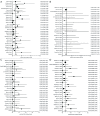Management of complicated and uncomplicated acute type B dissection. A systematic review and meta-analysis
- PMID: 24967162
- PMCID: PMC4052408
- DOI: 10.3978/j.issn.2225-319X.2014.05.08
Management of complicated and uncomplicated acute type B dissection. A systematic review and meta-analysis
Abstract
Background: The management of acute type B dissection represents a clinical challenge. We undertook a systematic review of the available literature regarding medical, surgical and endovascular treatments of acute type B aortic dissection and combined the eligible studies into a meta-analysis.
Methods: An extensive electronic health database search was performed on all articles published from January 2006 up to November 2013 describing the management of acute type B aortic dissection. Studies including less than 15 patients were excluded.
Results: ACUTE COMPLICATED TYPE B DISSECTION: overall, 2,531 patients were treated with endovascular repair (TEVAR) and the pooled rate for 30-day/in-hospital mortality was 7.3%. The pooled estimates for cerebrovascular events, spinal cord ischemia (SCI) and total neurologic events were 3.9%, 3.1% and 7.3%, respectively. A total of 1,276 patients underwent open surgical repair and the pooled rate for 30-day/in-hospital mortality was 19.0%. The pooled rate for cerebrovascular events was 6.8%, for SCI 3.3% and for total neurologic complications 9.8%. Acute uncomplicated type B dissection: outcome of 2,347 patients who underwent conservative medical management were analyzed. The pooled 30-day/in-hospital mortality rate was 2.4%. The pooled rate for cerebrovascular events was 1%, for SCI 0.8% and for overall neurologic complications 2%.
Conclusions: Endovascular repair provides a superior 30-day/in-hospital survival for acute complicated type B aortic dissection compared to surgical aortic reconstruction. However, open repair still has a significant role as endovascular repair is not applicable in all patients and there remains concerns regarding the durability of this technique. TEVAR seems to have a more favorable outcome regarding aortic remodeling and the aortic-specific survival rate when compared with medical therapy alone. Randomized controlled trials focusing on the prognostic factors of early and late complications in uncomplicated type B dissections are needed.
Keywords: Type B aortic dissection; acute; endovascular; medical treatment.
Figures




Similar articles
-
Conservative management versus endovascular or open surgery in the spectrum of type B aortic dissection.J Vis Surg. 2018 Mar 23;4:59. doi: 10.21037/jovs.2018.02.15. eCollection 2018. J Vis Surg. 2018. PMID: 29682469 Free PMC article.
-
Thoracic Endovascular Aortic Repair for Acute Aortic Dissection.Ann Vasc Dis. 2018 Dec 25;11(4):464-472. doi: 10.3400/avd.ra.18-00127. Ann Vasc Dis. 2018. PMID: 30637000 Free PMC article.
-
Thoracic endovascular repair of chronic type B aortic dissection: a systematic review.Ann Cardiothorac Surg. 2022 Jan;11(1):1-15. doi: 10.21037/acs-2021-taes-25. Ann Cardiothorac Surg. 2022. PMID: 35211380 Free PMC article.
-
Open surgical repair for chronic type B aortic dissection: a systematic review.Ann Cardiothorac Surg. 2014 Jul;3(4):340-50. doi: 10.3978/j.issn.2225-319X.2014.07.10. Ann Cardiothorac Surg. 2014. PMID: 25133097 Free PMC article. Review.
-
Endovascular repair of acute vs. subacute uncomplicated type B aortic dissection: a systematic review and meta-analysis.Front Cardiovasc Med. 2023 Jul 12;10:1189750. doi: 10.3389/fcvm.2023.1189750. eCollection 2023. Front Cardiovasc Med. 2023. PMID: 37502183 Free PMC article. Review.
Cited by
-
The current evidence on diagnosis and treatment of acute aortic syndrome.J Thorac Dis. 2016 Dec;8(12):E1617-E1619. doi: 10.21037/jtd.2016.12.03. J Thorac Dis. 2016. PMID: 28149596 Free PMC article. No abstract available.
-
Outcomes of Patients With Acute Type B (DeBakey III) Aortic Dissection: A 13-Year, Single-Center Experience.Circulation. 2015 Aug 25;132(8):748-54. doi: 10.1161/CIRCULATIONAHA.115.015302. Circulation. 2015. PMID: 26304666 Free PMC article.
-
Update on the Therapeutic Strategy of Type B Aortic Dissection.J Atheroscler Thromb. 2018 Mar 1;25(3):203-212. doi: 10.5551/jat.RV17017. Epub 2017 Nov 10. J Atheroscler Thromb. 2018. PMID: 29129854 Free PMC article. Review.
-
The Aortic Pathologies: How Far We Understand It and Its Implications on Thoracic Aortic Surgery.Braz J Cardiovasc Surg. 2021 Aug 6;36(4):535-549. doi: 10.21470/1678-9741-2020-0089. Braz J Cardiovasc Surg. 2021. PMID: 34617429 Free PMC article. Review.
-
Endovascular repair or best medical treatment: what is the optimal management of uncomplicated Type-B acute aortic dissection?J Thorac Dis. 2017 Oct;9(10):3458-3462. doi: 10.21037/jtd.2017.08.145. J Thorac Dis. 2017. PMID: 29268315 Free PMC article. No abstract available.
References
-
- Coady MA, Ikonomidis JS, Cheung AT, et al. Surgical management of descending thoracic aortic disease: open and endovascular approaches: a scientific statement from the American Heart Association. Circulation 2010;121:2780-804 - PubMed
-
- Fattori R, Cao P, De Rango P, et al. Interdisciplinary expert consensus document on management of type B aortic dissection. J Am Coll Cardiol 2013;61:1661-78 - PubMed
-
- Tsai TT, Trimarchi S, Nienaber CA. Acute aortic dissection: perspectives from the International Registry of Acute Aortic Dissection (IRAD). Eur J Vasc Endovasc Surg 2009;37:149-59 - PubMed
-
- Tsai TT, Evangelista A, Nienaber CA, et al. Long-term survival in patients presenting with type A acute aortic dissection: insights from the International Registry of Acute Aortic Dissection (IRAD). Circulation 2006;114:I350-6 - PubMed
-
- Nienaber CA, Kische S, Rousseau H, et al. Endovascular repair of type B aortic dissection: long-term results of the randomized investigation of stent grafts in aortic dissection trial. Circ Cardiovasc Interv 2013;6:407-16 - PubMed
Publication types
LinkOut - more resources
Full Text Sources
